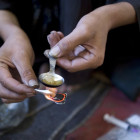
Jessica Williams: One Parent’s Advice for the Juvenile Justice System
|
Sharon Smith’s daughter Angela died in 1998 of a heroin overdose. She was 18 years old. For four years before her death, Angie was in and out of 11 treatment centers, stood before a half dozen judges, and lived at one juvenile detention center. Sharon formed MOMSTELL in 2000 to advocate for more effective, accessible drug treatment and greater family involvement across the continuum of care and in the policy-making process. “Because no family should have to face the disease of addiction alone,” MOMSTELL is committed to identifying and removing barriers to treatment, many of which Sharon encountered when trying to find help for her daughter. Sharon was one of the organizers of the "national dialogue" sponsored in 2009 by SAMHSA for Families of Youth with Substance Use Disorders. Here, she illustrates some of those barriers specific to juvenile justice. When Angie started to use drugs, were there adults in her life who tried to help her?
